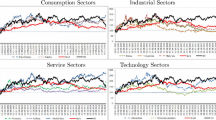Abstract
Commodities, especially gold and crude oil, are obvious to have a high fluctuation in recent years and lead a severe risk to investors. In this study, we consider a hedging strategy as a tool for offsetting the potential losses of investors. We develop various classes of Markov Switching constant conditional correlation GARCH model (MS-CCC-GARCH) to compute the optimal hedge ratios and portfolio weights in commodity markets (gold and crude oil) for the period of 2000–2018. We estimate three multivariate distributions MS-CCC-GARCH models (namely normal, student-t, and skewed student-t). The results find that MS-CCC-GARCH with student-t and normal distribution, for oil and gold, respectively, are the best model for hedge ratios and portfolio weights calculation in terms of the lowest AIC and BIC. Finally, the results of volatility and correlation of the best fit model are used to compute the value of hedge ratios and portfolio weights on gold and oil returns.
Access this chapter
Tax calculation will be finalised at checkout
Purchases are for personal use only
Similar content being viewed by others
References
Ahmad, W., Sadorsky, P., Sharma, A.: Optimal hedge ratios for clean energy equities. Econ. Model. 72, 278–295 (2018)
Billio, M., Caporin, M.: Multivariate Markov switching dynamic conditional correlation GARCH representations for contagion analysis. Stat. Methods Appl. 14(2), 145–161 (2005)
Billio, M., Casarin, R., Osuntuyi, A.: Efficient Gibbs sampling for Markov switching GARCH models. Comput. Stat. Data Anal. 100, 37–57 (2016)
Bollerslev, T.: Generalized autoregressive conditional heteroskedasticity. J. Econ. 31(3), 307–327 (1986)
Chang, C.L., González-Serrano, L., Jimenez-Martin, J.A.: Currency hedging strategies using dynamic multivariate GARCH. Math. Comput. Simul. 94, 164–182 (2013)
Chen, S., Lee, C., Shrestha, K.: Futures hedge ratios: a review. Q. Rev. Econ. Financ. 43, 433–465 (2003)
Chodchuangnirun, B., Yamaka, W., Khiewngamdee, C.: A regime switching for dynamic conditional correlation and GARCH: application to agricultural commodity prices and market risks. In: International Symposium on Integrated Uncertainty in Knowledge Modelling and Decision Making, pp. 289–301. Springer, Cham, March 2018
Hamilton, J.D.: A new approach to the economic analysis of nonstationary time series and the business cycle. Econometrica 57, 357–384 (1989)
Hamilton, J.D., Susmel, R.: Autoregressive conditional heteroskedasticity and changes in regime. J. Econ. 64(1–2), 307–333 (1994)
Hsu, C.C., Tseng, C.P., Wang, Y.H.: Dynamic hedging with futures: a copula-based GARCH model. J. Futur. Mark. 28(11), 1095–1116 (2008)
Johnson, L.L.: The theory of hedging and speculation in commodity futures. Rev. Econ. Stud. 27(3), 139–151 (1960)
Klaassen, F.: Improving GARCH volatility forecasts with regime-switching GARCH. In: Advances in Markov-Switching Models, pp. 223-254. Physica, Heidelberg (2002)
Lamoureux, C.G., Lastrapes, W.D.: Heteroskedasticity in stock return data: volume versus GARCH effects. J. Financ. 45(1), 221–229 (1990)
Pastpipatkul, P., Yamaka, W., Sriboonchitta, S.: Analyzing financial risk and co-movement of gold market, and indonesian, philippine, and thailand stock markets: dynamic copula with markov-switching. In: Causal Inference in Econometrics, pp. 565-586. Springer, Cham (2016)
Shrestha, K., Subramaniam, R., Peranginangin, Y., Philip, S.S.S.: Quantile hedge ratio for energy markets. Energy Econ. 71, 253–272 (2018)
Vovk, V.G.: A logic of probability, with application to the foundations of statistics. J. R. Stat. Soc. Ser. B (Methodological), 317–351 (1993)
Author information
Authors and Affiliations
Corresponding author
Editor information
Editors and Affiliations
Rights and permissions
Copyright information
© 2019 Springer Nature Switzerland AG
About this paper
Cite this paper
Chakpitak, N., Rakpho, P., Yamaka, W. (2019). Markov Switching Constant Conditional Correlation GARCH Models for Hedging on Gold and Crude Oil. In: Kreinovich, V., Sriboonchitta, S. (eds) Structural Changes and their Econometric Modeling. TES 2019. Studies in Computational Intelligence, vol 808. Springer, Cham. https://doi.org/10.1007/978-3-030-04263-9_36
Download citation
DOI: https://doi.org/10.1007/978-3-030-04263-9_36
Published:
Publisher Name: Springer, Cham
Print ISBN: 978-3-030-04262-2
Online ISBN: 978-3-030-04263-9
eBook Packages: Intelligent Technologies and RoboticsIntelligent Technologies and Robotics (R0)




